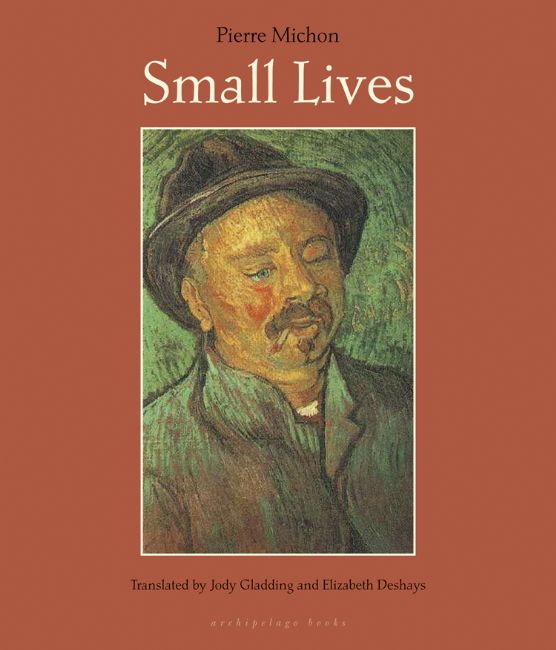
 Download this Reading Guide as a PDF
Download this Reading Guide as a PDF
Small Lives
By Pierre Michon
Translated by Jody Gladding and Elizabeth Deshays from the French
Discussion Points/Questions:
1. The first sentence of this book reads: “Let us explore a genesis for my pretensions.” How does this idea of a genesis, or an origin, figure throughout the narrator’s own life and the eight lives he describes? What relationships do characters such as André Dufourneau, Rémi Bakroot, and Father Bandy hold with their own origins? In what ways are one’s roots definitional, escapable or ineluctable for these and other characters, including the narrator? One might even ask what the very action of exploring one’s genesis means: what it would demand of the explorer and what results it would entail.
2. The word “shadow” is used throughout the narratives in a variety of contexts. Sometimes it is used only descriptively (for example, p. 12 or 119), other times metaphorically, such as to denote a memory or an absence of a person (p. 59 and 71). What role do shadows, these empty spaces inseparably linked to a person, play in the text; where else in the narrator’s life and the lives of his characters do they arise?
3. The narrator in “Small Lives” seems constantly aware of the fabricated quality of his stories. Using words and phrases like “perhaps” and “let us imagine…”, the narrator emphasizes the possible or verisimilar nature of the people and events he recalls, drawing attention to the fact that often no or only minimal historical records thereof persist. What genre, if any, could one ascribe to these fictively ambiguous stories? Furthermore, how do the characters within the novel themselves create partially false narratives of events and people in their memories and imagination, such as Eugène upon the visit of his grandson (pp. 74-5)? Is it even possible to capture faithfully the historical truth of the lived moments recalled in Small Lives?
4. The lives of the characters are often shown to mirror that of the narrator, whether the narrator states so explicitly or whether the comparison is only implied. For example, near the very beginning the narrator says of André Dufourneau, “For in speaking of him, I speak of myself” (p. 17). Other such similarities can be seen with characters from Antoine Peluchet to Father Foucault to Jean the paranoiac. What function do these characters thus play for the narrator in terms of presenting his own life? Or, alternatively, how does the life of the narrator influence how he portrays the characters? One might question whether the narrator is reading the characters into himself, or reading himself into the characters. Is Michon perhaps exploring a new genre – an autobiographical collage through the lives and stories of others? Finally, how can this type of examination of another lead to a greater understanding of oneself?
5. In “The Life of Georges Bandy” the disillusioned narrator cites an idea from the literary theory of his age: “writing is there where the world is not” (p. 144). Nonetheless, the narrator goes on to state that though he had lost the world, still he had not become a great writer. How does this juxtaposition between the earth and writing, the world and the word, play out in these series of lives? Looking at, for example, the progression of Father Bandy’s orations, or the narrator’s attempts in “The Life of Claudette” to write, is this concept of a pure or heavenly linguistic faculty false? Or is it simply impossible to reach – or, perhaps, only impossible for the imperfect narrator? Finally, can Small Lives itself be read as an attempt at either a “world-less” or a “worldly” writing, and if so, in what ways?
Suggestions for Further Reading & Exploration:
Online:
Benjamin Lytal reviews Small Lives in the New York Sun.
Read selections from Patrick Crowley’s Pierre Michon: The Afterlife of Names, in which Crowley examines Michon’s relation to the past and to contemporary literary theory.
Information, map, and photos of Châtelus-le-Marcheix, the town in Les Cards where Pierre Michon was born.
Look at examples of Van Gogh’s paintings of the French countryside at Amsterdam’s Van Gogh Museum.
Poetry of remembering the past and names:
The Iliad, Book 2, Line 484 (in brackets) and on.
John Keats’ “Ode on a Grecian Urn”.
In Print
Crowley, Patrick. Pierre Michon: The Afterlife of Names (Bern: International Academic Publishers, 2007).
Michon, Pierre. The Eleven. Translated by Elizabeth Deshays and Jody Gladding (Brooklyn: Archipelago Books, 2013).
—. Masters and Servants. Translated by Wyatt Mason (New Haven: Yale UP, 2013).
—. The Origin of the World. Translated by Wyatt Mason and Roger Shattuck (New Haven: Yale UP, 2013).
—. Rimbaud the Son. Translated by Elizabeth Deshays and Jody Gladding (New Haven: Yale UP, 2013).

Dear Archipalago Books,
I was delighted to see your translation of Michon’s ‘Vies minuscules’. The reading guide is a smart and engaging but could I ask you to change Peter Crowley to Patrick Crowley as the author of ‘Pierre Michon. The Afterlife of Names’? Best wishes, Patrick Crowley
Dear Patrick,
We’re very sorry about this, and we’ve updated the post.
All best,
Emma